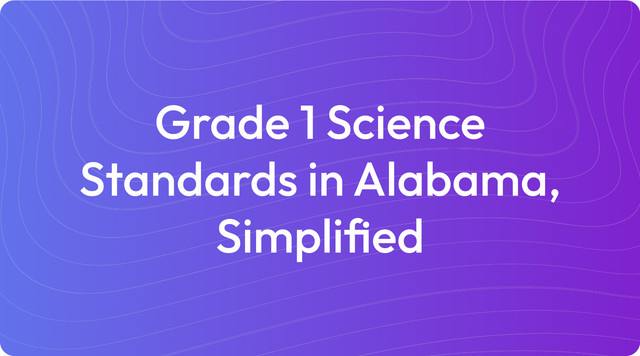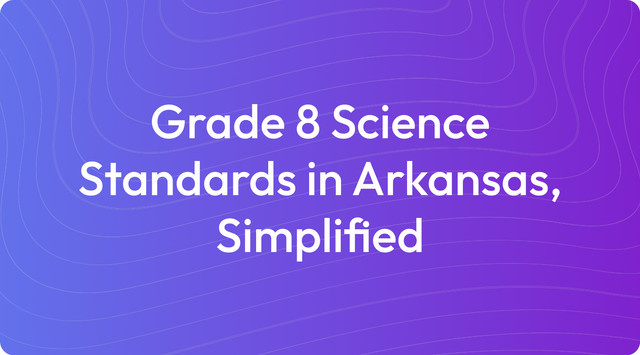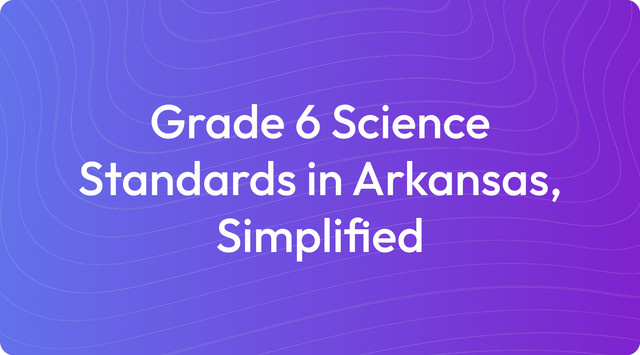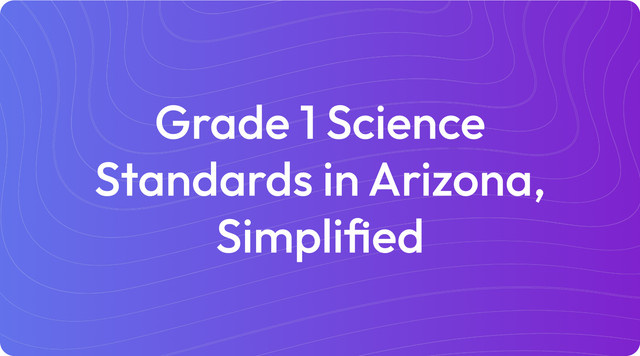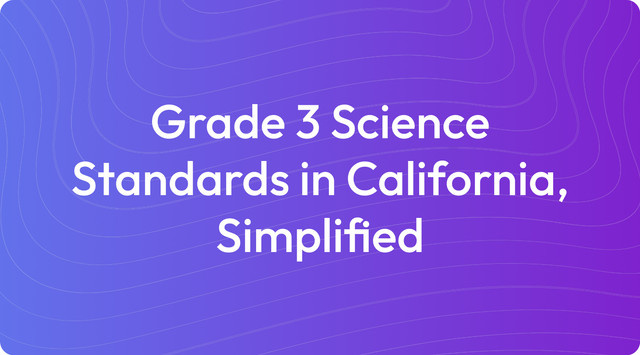Grade 8 Science Standards in Alaska, Simplified
Grade 8 science standards in Alaska include matter, energy, genetics, evolution, and Earth’s activity. Get the essentials—read more on TeachShare!
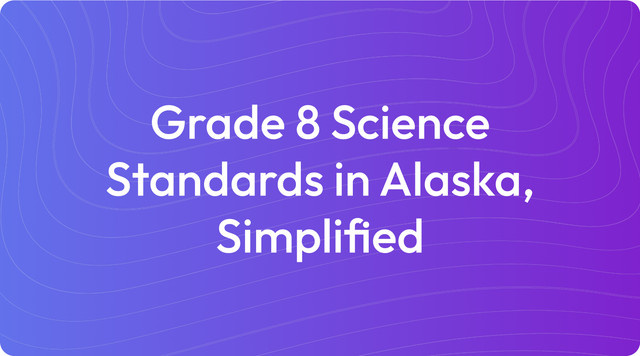
Creating effective lesson plans that align with state standards can be a time-consuming part of a teacher's work. We understand the need for practical resources that help you meet these requirements without starting from scratch. Our goal is to provide tools that support your expertise and make planning more manageable.
Education standards are learning goals that outline what students are expected to learn at each grade level. For teachers, they provide clear benchmarks for student progress but do not dictate specific teaching methods or materials. For instance, Alaska's Grade 8 Science Standards set expectations for students to analyze chemical reactions or design methods to monitor human impact, giving you a clear framework for your curriculum.
What Are Grade 8 Science Standards in Alaska?
The Grade 8 Science Standards in Alaska are built around four core areas of study, emphasizing a deeper exploration of Physical Science, Life Science, Earth and Space Science, and Engineering Design. These standards encourage hands-on investigations and real-world problem-solving to build critical thinking skills, often connecting learning to Alaska's unique environment. Here is a breakdown of the core standards for grade 8:
Physical Science (PS): Energy, Matter, and Waves
Standard MS-PS1-2: Analyze and interpret data on the properties of substances before and after interactions to determine if a chemical reaction has occurred.
Standard MS-PS3-1: Construct and interpret graphical displays of data to describe relationships of kinetic energy to the mass and speed of an object.
Standard MS-PS4-1: Use mathematical representations to describe a simple model for waves that includes how the amplitude and wavelength relate to the energy of the wave.
Standard MS-PS4-3: Integrate qualitative scientific and technical information to support the claim that digitized signals are more reliable than analog signals for encoding and transmitting information.
Life Science (LS): Adaptation, Genetics, and Ecosystems
Standard MS-LS1-4: Use argument based on evidence to explain how characteristic behaviors or specialized structures affect the probability of successful reproduction.
Standard MS-LS1-5: Construct a scientific explanation based on evidence for how environmental and genetic factors influence the growth of organisms.
Standard MS-LS4-4: Construct an explanation based on evidence that describes how genetic variations of traits in a population increase the likelihood of individuals surviving and reproducing.
Standard MS-LS2-3: Develop a model to describe the cycling of matter and flow of energy among living and nonliving parts of an ecosystem.
Earth and Space Science (ESS): Earth’s Systems and Human Impact
Standard MS-ESS2-2: Construct an explanation based on evidence for how geoscience processes have changed Earth’s surface over time.
Standard MS-ESS3-3: Apply scientific principles to design a method for monitoring and minimizing human impact on the environment.
Standard MS-ESS3-5: Ask questions to clarify evidence of the factors that have caused the rise in global temperatures over the past century.
Engineering Design (ETS): Problem-Solving
Standard MS-ETS1-1: Define a design problem that includes criteria and constraints.
Standard MS-ETS1-2: Evaluate competing design solutions to determine how well they meet the criteria and constraints of the problem.
Standard MS-ETS1-4: Develop a model to generate data for iterative testing and modification of a design.
Key Learning Goals for Grade 8 Science in Alaska
Physical Science: Students investigate chemical reactions, energy transfer, and wave behavior.
Life Science: Students explore how genetic traits and environmental factors influence survival, reproduction, and population dynamics.
Earth Science: Students study Earth’s processes (e.g., glaciers, volcanic activity) and human impacts on the environment, such as climate change and resource conservation.
Engineering Design: Students design, test, and refine solutions to real-world problems, such as earthquake-resistant structures or water filtration systems.
Connection to Alaska: Students explore local topics like Alaska’s ecosystems, geologic activity, and conservation practices to make learning relevant to their environment.
The framework for these standards is guided by the Next Generation Science Standards and adapted to connect with Alaska's unique environment and cultural context.
Key Tested Standards
The Alaska Science Assessment tests students on foundational concepts from Physical Science, Life Science, Earth and Space Science, and Engineering Design. These key tested standards assess your students’ ability to analyze data, create models, conduct investigations, and apply scientific principles to solve real-world problems. Below are the key tested standards for grade 8 science in Alaska:
Physical Science (PS): Energy, Matter, and Waves
Standard MS-PS1-2: Analyze and interpret data to determine if a chemical reaction has occurred based on properties before and after interactions.
Standard MS-PS3-1: Construct and interpret graphical displays of data to describe the relationship between kinetic energy, mass, and speed.
Standard MS-PS4-1: Use mathematical representations to describe a model for waves, including amplitude, wavelength, and energy.
Life Science (LS): Adaptation, Genetics, and Ecosystems
Standard MS-LS1-5: Construct a scientific explanation based on evidence for how environmental and genetic factors influence the growth of organisms.
Standard MS-LS2-3: Develop a model to describe the cycling of matter and flow of energy among living and nonliving parts of an ecosystem.
Standard MS-LS4-4: Construct an explanation for how genetic variations in traits increase the likelihood of survival and reproduction in specific environments.
Earth and Space Science (ESS): Earth’s Systems and Human Impact
Standard MS-ESS2-2: Construct an explanation for how geoscience processes have shaped Earth’s surface over time.
Standard MS-ESS3-3: Apply scientific principles to design a method for monitoring and minimizing human impact on the environment.
Standard MS-ESS3-5: Ask questions to clarify evidence of the factors that caused the rise in global temperatures over the past century.
Engineering Design (ETS): Problem-Solving
Standard MS-ETS1-1: Define the criteria and constraints of a design problem to ensure a successful solution.
Standard MS-ETS1-2: Evaluate competing design solutions to determine how well they meet criteria and constraints.
Standard MS-ETS1-4: Develop a model to generate data for iterative testing and modification of a design.
Why These Standards Are Key for Testing
These standards assess students’ ability to:
Analyze and Interpret Data: For example, investigating chemical reactions, plotting kinetic energy relationships, or interpreting climate data.
Develop and Use Models: For example, creating wave models, food webs, or systems to show energy flow and matter cycling.
Explain Phenomena with Evidence: For example, explaining adaptations in organisms or how geoscience processes shape Earth’s surface.
Solve Real-World Problems: For example, designing earthquake-resistant structures or creating solutions to reduce environmental impact.
This overview of tested standards is based on information from the Alaska Department of Education & Early Development and the Next Generation Science Standards.
Example Learning Objectives for Unit Planning
Learning objectives are clear, specific statements that describe what students will be able to do after a lesson or unit. They help you focus your instruction and provide students with a clear goal for their learning. These objectives translate the broader standards into actionable, measurable outcomes for your classroom.
To help you get started, here are some example learning objectives for the Grade 8 Science Standards in Alaska, written in student-friendly "I can" statements:
Physical Science (PS): Energy, Matter, and Waves
I can analyze data to determine if a chemical reaction has occurred by identifying evidence like gas production, color change, or temperature change.
I can describe how the mass and speed of an object affect its kinetic energy and represent this relationship in a graph.
I can create a model of waves to explain how amplitude and wavelength relate to the energy of the wave.
I can explain why digital signals are more reliable than analog signals for transmitting information, using examples like audio recordings or data storage.
Life Science (LS): Adaptation, Genetics, and Ecosystems
I can explain how environmental conditions (like sunlight or water) and genetic factors influence the growth of plants or animals.
I can create a model to show how energy flows and matter cycles in an ecosystem, including producers, consumers, decomposers, and the environment.
I can describe how specific traits, like fur color or beak shape, help animals survive and reproduce in different environments.
I can explain how specialized structures or behaviors, like pollination or bird calls, increase the chances of successful reproduction in plants and animals.
Earth and Space Science (ESS): Earth’s Systems and Human Impact
I can describe how geologic processes, like glaciers, earthquakes, or volcanic eruptions, have shaped Earth’s surface over time.
I can analyze data on greenhouse gas levels and global temperatures to explain the causes of climate change.
I can design and explain a solution to minimize human impact on the environment, like reducing pollution or conserving energy.
I can create a model to show how Earth’s systems (geosphere, biosphere, atmosphere, hydrosphere) interact, like the water cycle.
Engineering Design (ETS): Problem-Solving
I can identify a real-world problem, like protecting buildings from earthquakes, and define the criteria and constraints for solving it.
I can design and test a device, like a water filter or insulated container, and evaluate how well it meets the criteria.
I can improve a design by testing it, analyzing what works and what doesn’t, and making changes to make it better.
Sample "I Can" Learning Objectives
I can explain how energy moves through waves and how amplitude and wavelength relate to wave energy.
I can investigate how genetic traits, such as fur thickness, help animals survive in cold climates like Alaska’s tundra.
I can analyze data to explain how resource availability impacts population sizes in an ecosystem.
I can create a model to show how glaciers have shaped Alaska’s landscapes over time.
I can design and test a structure that minimizes damage from earthquakes and explain how it works.
Key Changes & Updates
The latest updates to Alaska's Grade 8 Science Standards reflect a significant shift toward more active, hands-on learning. There is a greater focus on inquiry-based investigations and the integration of engineering design principles directly into the curriculum. This change encourages you to guide students as they define problems, test solutions, and learn through doing. The goal is to build critical thinking and problem-solving skills by having students engage with science in a practical, tangible way.
The updated standards also place a strong emphasis on connecting science to real-world issues and Alaska’s unique environment. Your curriculum can now more directly address topics like climate change, human impact on ecosystems, and how genetic traits influence adaptation in local wildlife. By exploring Alaska-specific examples, from glacial formations to local resource management, learning becomes more relevant for students. These standards also incorporate math and literacy skills, asking students to analyze data and construct evidence-based arguments, reinforcing learning across subjects.
Create with TeachShare
We know that turning these standards into engaging, classroom-ready materials takes time and effort. Our platform is designed to help you build high-quality lessons and activities that align with Alaska's science standards. You can create differentiated assignments, apply effective teaching strategies, and get back to what you do best—teaching. Start creating standards-aligned instructional resources with TeachShare now.
Frequently Asked Questions
What are the main topics covered in Grade 8 Science in Alaska?
Grade 8 science in Alaska is built around four core areas of study. Here’s a look at what your students will explore:
- Physical Science: This includes energy transfer, chemical reactions, and the properties of waves.
- Life Science: Students learn about genetics, natural selection, and how energy and matter cycle through ecosystems.
- Earth and Space Science: This covers geologic processes, Earth’s systems, and the effects of human activity on the environment.
- Engineering Design: Students practice defining problems, creating solutions, and testing their designs.
How do the Grade 8 Science Standards connect to Alaska’s environment?
A great feature of these standards is their direct connection to Alaska. They encourage you to use local examples to make science tangible for students. This includes:
- Studying how glaciers, earthquakes, and volcanic activity have formed Alaska’s unique terrain
- Exploring local ecosystems like tundra, boreal forests, and marine environments
- Examining the regional effects of climate change, such as melting permafrost
- Looking at resource management challenges specific to Alaska, like sustainable fishing
What are some examples of hands-on activities for Grade 8 Science?
The standards are designed for active learning. Here are a few ideas for hands-on activities you can use in your classroom:
- Physical Science: Use a rope or slinky to create models of waves and measure their properties.
- Life Science: Have students build a food web model to show how energy moves through an ecosystem.
- Earth Science: Simulate glacial erosion to demonstrate how physical features are formed.
- Engineering Design: Challenge students to design and build earthquake-resistant structures with specific materials and cost limits.
How are students assessed in Grade 8 Science?
Assessment focuses on what students can do, not just what they know. You can evaluate their understanding through a variety of performance-based methods, such as:
- Investigations: Students can test how factors like mass and speed influence kinetic energy.
- Models: They can create diagrams or physical models to represent concepts like wave patterns or food webs.
- Data Analysis: Students can interpret charts and graphs showing temperature trends or changes in animal populations.
- Design Projects: They can design, build, and improve solutions to problems, like a water filter or an insulated box.
How can teachers make Grade 8 Science engaging for students?
Keeping students interested is key, and these standards offer many opportunities to do just that. We find these approaches work well:
- Use Real-World Problems: Ask students to analyze climate change impacts in their community or design ways to reduce local pollution.
- Incorporate Hands-On Learning: Let students get their hands dirty with experiments, model building, and design challenges.
- Relate to Alaska’s Environment: Use the state’s unique environment as a living laboratory for studying glaciers, ecosystems, and resource management.
- Encourage Collaboration: Assign group projects where students can work as a team to solve problems and present their findings.
Answer


